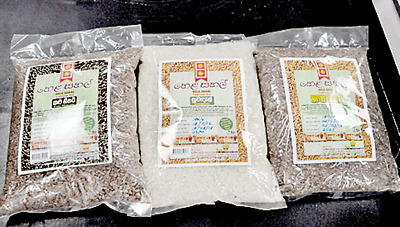An indigenous path to better health
Of the 15 or so indigenous rice varieties he has helped farmers cultivate, Srinath Manamperi likes the red grains of Ma Vee the best. A modest helping will fuel him for hours, giving him stamina and energy. The rice has a subtle aroma, is high in fibre and when made into porridge is prescribed by practitioners of Ayurveda as a cure for hangovers.

Srinath Manamperi
But Srinath also has an eye on the bigger picture. Ma Vee and other traditional varieties offer clear health benefits to consumers but he’s equally excited by what they can do for farmers. “I want farmers to become entrepreneurs,” he says. Through his Kandy based company Hela Govi Vyaparaya, Srinath supplies an estimated 10,000 farmers across the island with the seeds they need to grow the once widespread indigenous rice strains – together farmer and businessman are creating a movement they’d like to see take hold in Sri Lanka.
“These traditional varieties are now becoming extinct,” Srinath explains. This would be nothing less than a tragedy because over the centuries these varieties have become exquisitely well adapted to Sri Lankan conditions. According to Srinath, there is a rice to suit every climate and soil on the island. Madathawalu grows well in the Central Province and in the hills. Rathkandu and Kalkandu are both resistant to cold while El Vee is best grown in dry, hilly areas. Ma Vee itself is a friend to farmers who would cultivate it in flood-prone areas – the fast growing plant can reach as high as 6ft, simply lifting itself clear above the floodwaters, he says.
Though only a handful are actively cultivated today, according to ancient records the inhabitants of the island at one time could have partaken of any one of an estimated 3,000 varieties of rice. Many of those are now lost and only 1,000 or so are still known. Srinath says that we have this much at least thanks to the many small farmers who though forced to grow hybrid rice varieties to earn a living kept the seeds of the traditional ones safe.
Srinath who has a background in bioscience and a degree in management, says he completed his education with the odd course from the Agriculture Department. His real learning however has come from out in the field, in conversation with farmers who have willingly shared their knowledge and their seeds with him. Wherever possible, Srinath has entered into partnerships with farmers’ collectives and says he even does business in the North and East (the rice variety the Tamils calls Cheenati does well in those parts.) His strategy is simple: he provides the farmers with the seeds and then buys the paddy back from them at a good price. He redistributes the grains and sells the excess on the market.
Of course, in practice things can get a lot more complicated. Part of Srinath’s approach is to ensure that his farmers use only organic methods to grow the rice, relying on the likes of kohomba seeds and daluk to keep pests at bay. In the wake of kidney diseases, he sees this as being essential to protecting their health and that of his consumers. However, for the cash-strapped farmers the real deal breaker may be in how long the crop takes to mature – some of the indigenous rice need six months before they are ready for harvest. It’s why Srinath is willing to pay his farmers triple the standard price for their paddy but it also drives his own price up. His brand is available in select stores in and around Kandy and will be in Colombo by the end of the year, but will customers pay Rs.180 for a kg when they could have a more familiar hybrid rice for under Rs.60?
 |
 Srinath’s brand and top, a paddy field where a traditional rice variety is grown |
Srinath is confident that customers who can afford it would choose the indigenous variety if only they knew the great health benefits that came along with consuming them. The traditional rice varieties are known to have a low Glycemic Index (GI) – they release their sugars slowly over a period of time, making them ideal for diabetic patients. They’re also significantly higher in fibre and protein content and are a rich source of antioxidants.
Quoting from the Charaka Samhitha (believed to be the oldest of the three surviving ancient treatises of Ayurveda) and the Sushruta Samhitha both of which are still central to the modern-day practice of Ayurvedic medicine, Srinath says each variety boasts its own benefits. Hatadaa Vee boosts stamina and improves bowel movements, while Rath El is said to improve the complexion and cure skin disease. It is also considered a cure for bladder disease and gallstones, and is prescribed for patients with tuberculosis. Kuruluthuda also improves the health of the bladder while Kaluheenati is used in the treatment of snake bites. Pachchaperumal is believed to be particularly good for children.
If Srinath has his way, local households will grow accustomed to eating different varieties according to the season. He knows however that his biggest challenge will be to keep his farmers cultivating these varieties. To support his sales, he needs to maintain a large stock, something he is finding a challenge in the current economic context. For the farmer, the hybrids provide a higher yield, on faster turnaround times, but are costly as they require agro chemicals and fertilisers. However, Srinath may have found an unexpected ally in the changing climate: traditional rice strains are much hardier as well as more resistant to disease.
Particularly encouraging is the support he has received from the Southern Province Development Authority and Farmer Federation for the Conservation of Traditional Seeds and Agri-Resources. Srinath says the former are encouraging farmers in coastal belts to grow Ma Vee. As far he’s concerned, it’s the first step in the right direction.
For more information on traditional rice varieties and where to find them contact Srinath on +94 714 429 952.
Follow @timesonlinelk
comments powered by Disqus




























